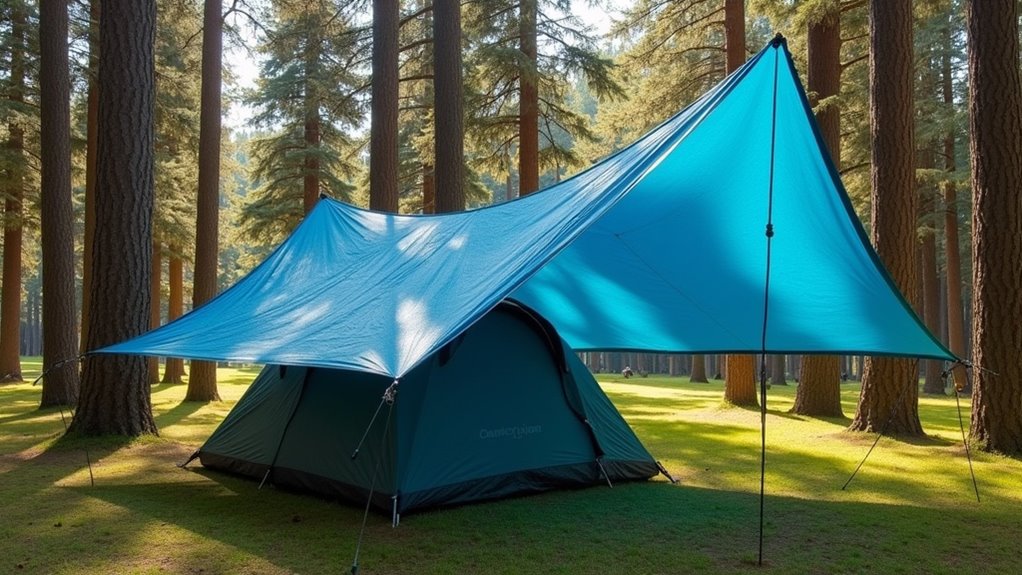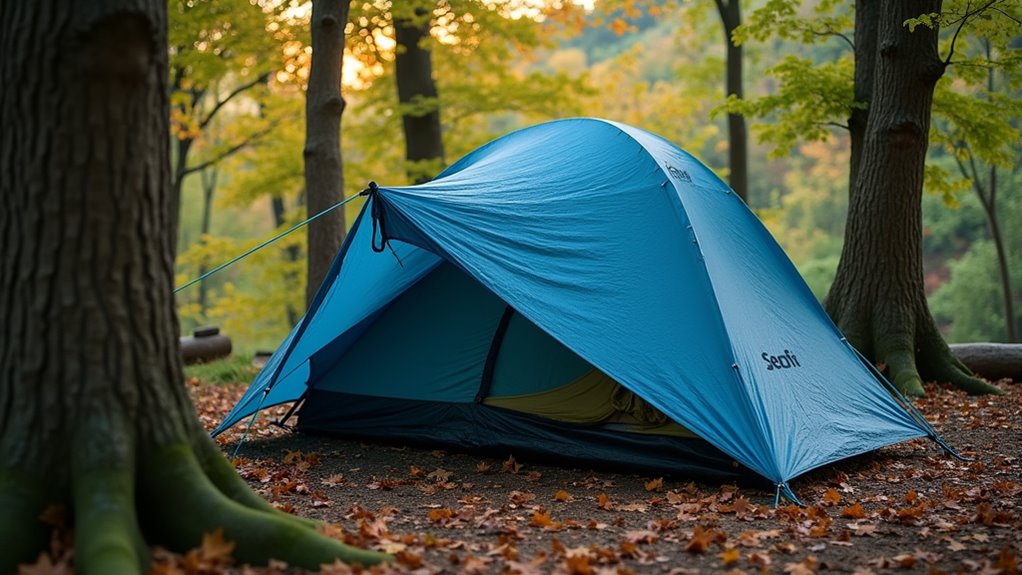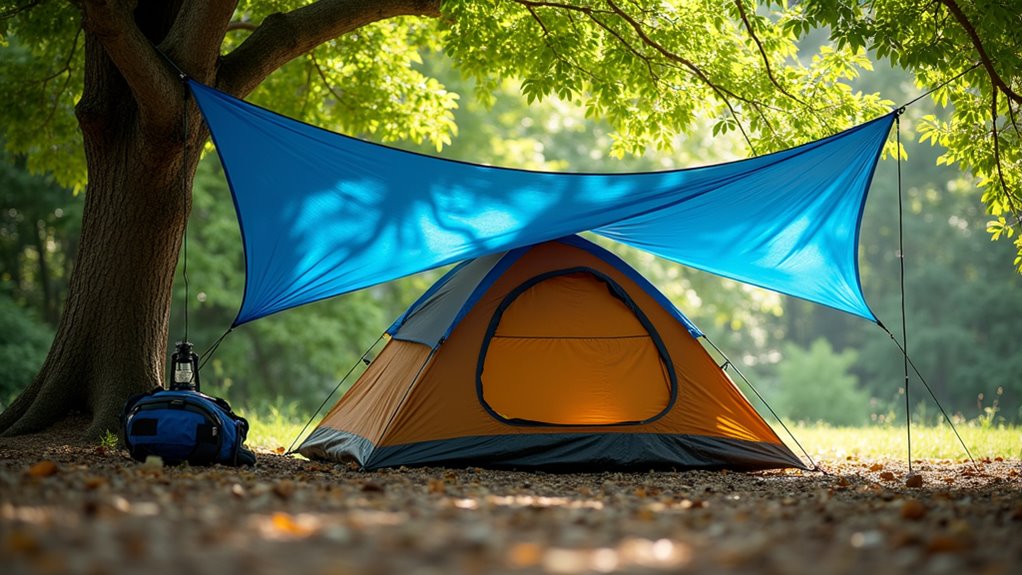How To Put A Tarp Over A Tent
This post contains affiliate links. As an Amazon Associate, we earn from qualifying purchases.
To put a tarp over your tent effectively, choose flat ground with natural windbreaks and secure a durable tarp at a 30-degree angle above your tent’s ridgeline, allowing for a 6-to-12 inch overhang. Use strong knots like the Bowline at the corners and the Trucker’s Hitch to maintain tension. These steps help ensure good water runoff, protection, and ventilation. Further explanation and detailed techniques will be provided in the following sections for those interested in a deeper understanding.
Essential Facts in 30 Seconds
- Choose flat ground with natural windbreaks and a durable tarp.
- Align the tarp’s ridge with the tent’s ridgeline for full coverage.
- Secure tarp corners tightly using bowline knots with extra knots for security.
- Angle the tarp at 30 degrees for water runoff with a 6 to 12-inch overhang.
- Anchor corners first and maintain airflow to reduce moisture inside the tent.
Selecting the Right Location and Anchoring Techniques

Select a flat spot for your tarp and tent. Flat ground stops water from pooling underneath. Avoid low areas where rain can collect.
Find natural windbreaks such as bushes or hills to block strong winds. Use a strong tarp material that lasts through tough weather. Picking a tarp bigger than your tent ensures adequate coverage and protection. Set the tarp at a 30-degree angle to let water run off. Keep it tight to stop sagging and water pockets.
Tie the tarp to nearby trees or rocks for support. Change the height and angle to balance air flow and shelter. Use adjustable poles if there are no natural anchors. Additionally, using a tarp can help provide extra insulation from cold ground temperatures during chilly nights.
Check your tarp and tent often. Tighten ropes and stakes during bad weather. These steps keep you dry and safe while camping. Additionally, ensuring proper ground cover can enhance your overall comfort and protection from the elements.
Understanding Rope Knots and Tensioning Methods
Knowing how to tie rope knots and tighten ropes helps you set up a tarp well. Learn simple knots for a strong, steady hold. The Trucker’s Hitch tightens ropes just right, making your shelter firm. Use the Bowline Knot to tie tarp corners. This knot makes a loop that stays put under pressure. Remember that tent pegs are essential for overall tent security.
The Adjustable Guyline Hitch lets you change tension fast. The Prusik Knot grips well and moves if needed. Remember that guy ropes are essential for overall tent security. Finish by tying half hitches to lock the rope tight. Check knots often. Wind and rain can loosen them. These knots keep your tarp tight and safe against bad weather.
Proper Positioning of the Tarp Over the Tent

Place the tarp so its center ridge lines up with the tent’s ridgeline. This alignment gives the best coverage and keeps rain off. Move the tarp forward or backward to cover the tent’s door and weak sides. Keep equal overhang on both sides for good water flow. Let the tarp extend 6 to 12 inches beyond the tent’s edge to stop water from pooling.
Raise the tarp high enough so it doesn’t touch the tent. This space lets air flow and cuts down on inside moisture. Keep at least 2 feet of space between the tarp edges and the ground.
Set the tarp at a steep angle, about 30 degrees. This slope helps water run off fast and away from the door.
Think about wind and sun direction. Position the tarp to block wind and give shade. This setup offers the best shelter and protection.
Anchoring and Securing the Tarp Corners
Securing tarp corners keeps your shelter strong and safe from wind and rain. Use bowline knots to make small loops at each corner. These loops hold well and don’t slip. Add overhand knots on a bight near corners for tighter loops. These fit over poles or stakes without sliding off.
Use trucker’s hitch knots to pull the tarp tight. This keeps the tarp snug and stops flapping. The right peg choice significantly impacts tent performance and can help ensure your tarp remains secure.
Tie strong guylines to tarp corners. Attach these lines to trees or heavy stakes. Pull knots tight to stop the tarp from moving. Check and tighten knots often, especially on windy days. Additionally, ensure the tarp is anchored properly with secure stakes to prevent any lifting during storms.
Use more than one anchor point per corner if possible. This spreads the force and makes your shelter last longer. Small steps like these make a big difference in keeping your tarp secure.
Enhancing Protection and Ventilation Benefits

Anchor and secure your tarp corners first. Then, focus on protection and ventilation. A well-placed tarp keeps rain and sun away from your tent. It also helps air flow, cutting down moisture inside. This keeps you dry and comfy. Additionally, using a tarp acts as a moisture barrier, further enhancing your camping experience. Setting up the tarp in an A-frame style can provide added stability against the elements.
| Benefit | Description | Impact |
|---|---|---|
| Rain Protection | Stops water from entering seams and zippers. | Keeps inside dry and cozy. |
| Temperature Control | Blocks sunlight, lowering inside heat. | Makes hot days more comfortable. |
| Ventilation | Allows air to move, stops stale air. | Reduces moisture and mold risk. |
| UV Protection | Protects tent fabric from sun damage. | Makes tent last longer. |
Pick strong tarps that fit weather changes. A tarp adds space and comfort. It creates a small safe area. Stay dry, cool, and enjoy nature fully.
Frequently Asked Questions
What Type of Tarp Material Is Best for Camping?
Polyethylene tarps stand out for camping. They resist water well and last through tough weather. Canvas tarps breathe better and feel strong. They work well for longer trips. Think about your trip and weather to pick the right tarp. Durable, waterproof, or breathable—each has a clear use. Choose what fits your camping style best.
Can I Use a Tarp in Winter Conditions?
Using a tarp in winter camping works very well. It can keep you warmer by about 30%. Set it up strong to block snow and wind. Add insulation under the tarp for extra heat. A good tarp keeps cold air out and holds warmth in. It also protects your gear from snow and moisture. Simple tricks make winter camping safer and more comfortable.
How Do I Clean and Maintain My Tarp?
Clean your tarp using mild soap and warm water. Use a soft brush or cloth to avoid damage. Rinse the tarp well to remove all soap. Let it dry fully before storing to prevent mold. Store the tarp flat or rolled in a cool, dry area. Check the tarp often for tears or holes. Fix small holes quickly with patch kits to extend its life. Proper care helps your tarp last longer and stay strong.
What Are Alternative Methods if No Trees Are Available?
No trees? No problem. Use portable poles to hold up your tarp. Secure the edges with strong stakes or heavy rocks. This method keeps your tarp tight and stable. Many campers trust this setup when trees are missing. It works well on open ground or rocky areas. Simple tools and smart placement make a big difference. Stay dry and protected without needing trees nearby.
How Can I Prevent Wind From Lifting the Tarp?
Tarp weights at each corner stop wind from lifting the tarp. Place heavy objects like bricks or sandbags there. Build barriers such as bushes or fences to block strong gusts. Keep the tarp low and tight to the ground. This reduces flap and stops air from getting underneath. Strong winds can lift loose tarps easily. A tight, weighted tarp stays put during storms.
Conclusion
Putting a tarp over your tent protects you from rain and wind. It acts like a strong shield, keeping water out. Pick a flat spot without sharp rocks or sticks. Use strong ropes to tie the tarp tightly. Make sure the tarp is stretched so water runs off fast. Avoid letting water collect on the tarp—it can cause leaks. Secure all corners with stakes or heavy objects. This simple setup keeps your tent dry and cozy. Enjoy your camping trip without worrying about bad weather.
